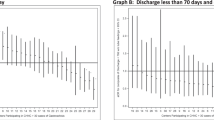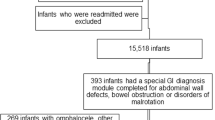Abstract
Objective
Compare in-hospital outcomes in gastroschisis with intestinal atresia versus simple gastroschisis (GS) using a national database.
Study design
The Children’s Hospitals Neonatal Database identified infants with gastroschisis from 2010 to 2016.
Results
2078 patients with gastroschisis were included: 183 (8.8%) with co-existing intestinal atresia, 1713 (82.4%) with simple gastroschisis, the remainder with complex gastroschisis without atresia. Length of hospitalization was longer for those with atresia, and yielded higher rates of mortality, medical NEC, and intestinal perforation. They began enteral feedings later, were less likely to initiate feeds orally, and reached full feedings later. They were less likely to be receiving any maternal breast milk or breastfeeding at discharge and more likely than simple gastroschisis to be discharged with a feeding tube.
Conclusion
A large multicenter cohort showed gastroschisis with atresia results in worse outcomes and complications, including necrotizing enterocolitis, feeding delays, and enteral feeding tube dependence.
This is a preview of subscription content, access via your institution
Access options
Subscribe to this journal
Receive 12 print issues and online access
$259.00 per year
only $21.58 per issue
Buy this article
- Purchase on SpringerLink
- Instant access to full article PDF
Prices may be subject to local taxes which are calculated during checkout
Similar content being viewed by others
References
Short TD, Stallings EB, Isenburg J, O’Leary LA, Yazdy MM, Bohm MK, et al. Gastroschisis trends and ecologic link to opioid prescription rates - United States, 2006–2015. MMWR Morb Mortal Wkly Rep. 2019;68:31–6.
Molik KA, Gingalewski CA, West KW, Rescorla FJ, Scherer LR, Engum SA, et al. Gastroschisis: a plea for risk categorization. J Pediatr Surg. 2001;36:51–5.
Abdullah F, Arnold MA, Nabaweesi R, Fischer AC, Colombani PM, Anderson KD, et al. Gastroschisis in the United States 1988–2003: analysis and risk categorization of 4344 patients. J Perinatol. 2007;27:50–5.
Arnold MA, Chang DC, Nabaweesi R, Colombani PM, Bathurst MA, Mon KS, et al. Risk stratification of 4344 patients with gastroschisis into simple and complex categories. J Pediatr Surg. 2007;42:1520–5.
Friedmacher F, Hock A, Castellani C, Avian A, Hollwarth ME. Gastroschisis-related complications requiring further surgical interventions. Pediatr Surg Int. 2014;30:615–20.
Lao OB, Larison C, Garrison MM, Waldhausen JH, Goldin AB. Outcomes in neonates with gastroschisis in U.S. children’s hospitals. Am J Perinatol. 2010;27:97–101.
Snyder CL, Miller KA, Sharp RJ, Murphy JP, Andrews WA, Holcomb GW 3rd, et al. Management of intestinal atresia in patients with gastroschisis. J Pediatr Surg. 2001;36:1542–5.
Cusick E, Spicer RD, Beck JM. Small-bowel continuity: a crucial factor in determining survival in gastroschisis. Pediatr Surg Int. 1997;12:34–7.
Payne NR, Pfleghaar K, Assel B, Johnson A, Rich RH. Predicting the outcome of newborns with gastroschisis. J Pediatr Surg. 2009;44:918–23.
Tower C, Ong SS, Ewer AK, Khan K, Kilby MD. Prognosis in isolated gastroschisis with bowel dilatation: a systematic review. Arch Dis Child Fetal Neonatal Ed. 2009;94:F268–74.
Nick AM, Bruner JP, Moses R, Yang EY, Scott TA. Second-trimester intra-abdominal bowel dilation in fetuses with gastroschisis predicts neonatal bowel atresia. Ultrasound Obstet Gynecol. 2006;28:821–5.
Mutanen A, Koivusalo A, Pakarinen M. Complicated gastroschisis is associated with greater intestinal morbidity than gastroschisis or intestinal atresia alone. Eur J Pediatr Surg. 2018;28:495–501.
Emil S, Canvasser N, Chen T, Friedrich E, Su W. Contemporary 2-year outcomes of complex gastroschisis. J Pediatr Surg. 2012;47:1521–8.
Murthy K, Dykes FD, Padula MA, Pallotto EK, Reber KM, Durand DJ, et al. The Children’s Hospitals Neonatal Database: an overview of patient complexity, outcomes and variation in care. J Perinatol. 2014;34:582–6.
Murthy K, Evans JR, Bhatia AM, Rothstein DH, Wadhawan R, Zaniletti I, et al. The association of type of surgical closure on length of stay among infants with gastroschisis born>/=34 weeks’ gestation. J Pediatr Surg. 2014;49:1220–5.
Fraser JD, Deans KJ, Fallat ME, Helmrath MA, Kabre R, Leys CM, et al. Sutureless vs sutured abdominal wall closure for gastroschisis: operative characteristics and early outcomes from the Midwest Pediatric Surgery Consortium. J Pediatr Surg. 2020;55:2284–8.
Kunz SN, Tieder JS, Whitlock K, Jackson JC, Avansino JR. Primary fascial closure versus staged closure with silo in patients with gastroschisis: a meta-analysis. J Pediatr Surg. 2013;48:845–57.
Alshehri A, Emil S, Laberge JM, Skarsgard E. Canadian Pediatric Surgery N. Outcomes of early versus late intestinal operations in patients with gastroschisis and intestinal atresia: results from a prospective national database. J Pediatr Surg. 2013;48:2022–6.
McGuire W, McEwan P. Systematic review of transpyloric versus gastric tube feeding for preterm infants. Arch Dis Child Fetal Neonatal Ed. 2004;89:F245–8.
Cotten CM, Taylor S, Stoll B, Goldberg RN, Hansen NI, Sanchez PJ, et al. Prolonged duration of initial empirical antibiotic treatment is associated with increased rates of necrotizing enterocolitis and death for extremely low birth weight infants. Pediatrics. 2009;123:58–66.
Kuppala VS, Meinzen-Derr J, Morrow AL, Schibler KR. Prolonged initial empirical antibiotic treatment is associated with adverse outcomes in premature infants. J Pediatr. 2011;159:720–5.
Acknowledgements
Jeanette Asselin, David Durand (ex officio), Francine Dykes (ex officio), Jacquelyn Evans, Karna Murthy, Michael Padula, Eugenia Pallotto, Theresa Grover, Beverly Brozanski, Anthony Piazza, Kristina Reber, and Billie Short are members of the Children’s Hospitals Neonatal Consortium, Inc. (site: thechnc.org). For more information, please contact: support@thechnc.org We are indebted to the following institutions that serve the infants and their families, and these institutions also have invested in and continue to participate in the Children’s Hospital’s Neonatal Database (CHND). The site sponsors/contributors for the CHND are also included: 1 Children’s Healthcare of Atlanta, Atlanta, GA (Anthony Piazza). 2 Children’s Healthcare of Atlanta at Scottish Rite (Gregory Sysyn). 3 Children’s Hospital of Alabama, Birmingham, AL (Carl Coghill, Allison Black). 4 Le Bonheur Children’s Hospital, Memphis, TN (Ramasubbareddy Dhanireddy). 5 Children’s Hospital Boston, Boston, MA (Anne Hansen, Tanzeema Hossain). 6 Ann & Robert H. Lurie Children’s Hospital of Chicago, Chicago, IL (Karna Murthy, Gustave Falciglia). 7 Cincinnati Children’s Hospital, Cincinnati, OH (Beth Haberman, Amy Nathan, Kristin Nelson, Paul Kingma, Stefanie Riddle, Stephanie Merhar, Heather Kaplan). 8 Nationwide Children’s Hospital, Columbus, OH (Kristina Reber). 9 Children’s Medical Center, Dallas, TX (Rashmin Savani, Luc Brion, Noorjahan Ali). 10 Children’s Hospital Colorado, Aurora, CO (Theresa Grover). 11 Children’s Hospital of Michigan, Detroit, MI (Girija Natarajan). 12 Cook Children’s Health Care System, Fort Worth, TX (Jonathan Nedrelow, Annie Chi, Yvette Johnson). 13 Texas Children’s Hospital, Houston, TX (Gautham Suresh). 14 Riley Children’s Hospital, Indianapolis, IN (William Engle, Lora Simpson, Gregory Sokol). 15 Children’s Mercy Hospitals & Clinics, Kansas City, MO (Eugenia Pallotto). 16 Arkansas Children’s Hospital, Little Rock, AR (Robert Lyle, Becky Rogers). 17 Children’s Hospital Los Angeles, Los Angeles, CA (Steven Chin, Rachel Chapman). 18 American Family Children’s Hospital, Madison, WI (Jamie Limjoco, Lori Haack). 19 Children’s Hospital & Research Center Oakland, Oakland, CA (David Durand, Jeanette Asselin, Art D’Harlingue, Priscilla Joe). 20 The Children’s Hospital of Philadelphia, Philadelphia, PA (Jacquelyn Evans, Michael Padula, David Munson). 21 St. Christopher’s Hospital for Children, Philadelphia, PA (Suzanne Touch). 22 Children’s Hospital of Pittsburgh of UPMC, Pittsburgh, PA (Toby Yanowitz). 23 St. Louis Children’s Hospital, St Louis, MO (Beverly Brozanski, Rakesh Rao). 24 All Children’s Hospital, St. Petersburg, FL (Victor McKay). 25 Rady Children’s Hospital, San Diego, CA (Mark Speziale, Brian Lane, Laural Moyer). 26 Children’s National Medical Center, Washington, DC (Billie Short, Lamia Soghier). 27 AI DuPont Hospital for Children, Wilmington, DE (Kevin Sullivan). 28 Primary Children’s Medical Center, Salt Lake City, UT (Con Yee Ling, Shrena Patel). 29 Children’s Hospital of Wisconsin, Milwaukee, WI (Michael Uhing, Ankur Datta). 30 Children’s Hospital & Medical Center, Omaha, NE (Nicole Birge). 31 Florida Hospital for Children (Rajan Wadhawan). 32 Seattle Children’s Hospital, Seattle, WA (Elizabeth Jacobsen-Misbe, Robert DiGeronimo, Zeenia Billimoria). 33 Hospital for Sick Children, Toronto, ON (Kyong-Soon Lee). 34 Children’s Hospital Orange County, Los Angeles, CA (Michel Mikhael, Irfan Ahmad).
Author information
Authors and Affiliations
Consortia
Contributions
The authors affirm that all authors have participated in the concept and design. I.Z. performed data analysis. All authors participated in interpretation of data, drafting, and revising of the manuscript, and that they have approved the manuscript as submitted.
Corresponding author
Ethics declarations
Competing interests
The authors declare no competing interests.
Additional information
Publisher’s note Springer Nature remains neutral with regard to jurisdictional claims in published maps and institutional affiliations.
Supplementary information
Rights and permissions
About this article
Cite this article
Riddle, S., Haberman, B., Miquel-Verges, F. et al. Gastroschisis with intestinal atresia leads to longer hospitalization and poor feeding outcomes. J Perinatol 42, 254–259 (2022). https://doi.org/10.1038/s41372-021-01131-5
Received:
Revised:
Accepted:
Published:
Issue date:
DOI: https://doi.org/10.1038/s41372-021-01131-5
This article is cited by
-
Inter-center variations in inpatient outcomes for infants with gastroschisis from the Children’s Hospitals Neonatal Consortium
Journal of Perinatology (2025)
-
The outcomes of treatment between primary closure and staged closure in gastroschisis in the pre and post era of the bedside wound retractor silo placement technique
Pediatric Surgery International (2025)
-
Early versus delayed silo closure in gastroschisis: a retrospective study
Pediatric Surgery International (2025)
-
Is anemia frequently recognized in gastroschisis compared to omphalocele? A multicenter retrospective study in southern Japan
Pediatric Surgery International (2022)



